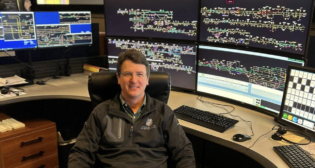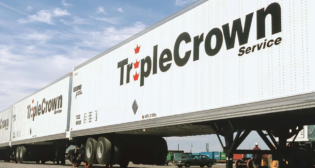
Digitizing Drainage
Written by Carolina Worrell, Senior Editor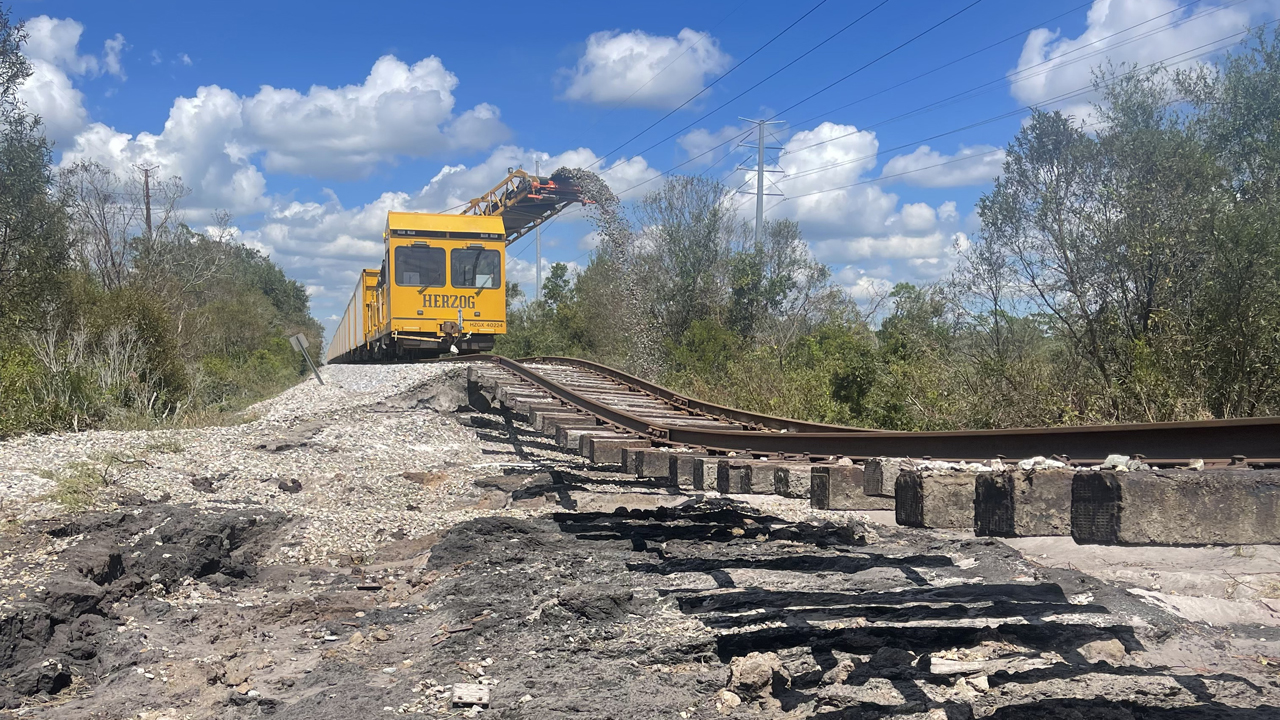
Herzog’s ACT was used to assist with reconstruction of tracks impacted by Hurricane Ian in southwest Florida. (Photograph Courtesy of Herzog)
RAILWAY AGE NOVEMBER 2022 ISSUE: High-production machines and attachments, as well as computerized inspection vehicles, are built by (and sometimes operated under) multiple suppliers to help dump, spread, tamp, profile and clean ballast, helping to keep track in its place.
Any experienced railroad civil engineer will tell you that track is only as good as the ballast holding it in place. Ballast serves many purposes, the most important of which is drainage. High-production, computer-driven track machines and inspection vehicles perform one of the most critical of maintenance-of-way (m/w) functions: keeping ballast in a state-of-good-repair (SOGR) to provide a smooth-running surface with excellent drainage.
Railway Age contacted the following suppliers to find out about their latest technologies and what their customers are looking for, as well as the state of the market: Brandt Road Rail, BTE (Ballast Tools Equipment), DymaxRail, HRSI (Herzog Railroad Services), Knox Kershaw, Loram, Miner Enterprises, Plasser American, RCE (Rail Construction Equipment Co.), Ontario Trap Rock and Mitchell Railgear. Following is a roundup of offerings from suppliers who responded to our inquiries.
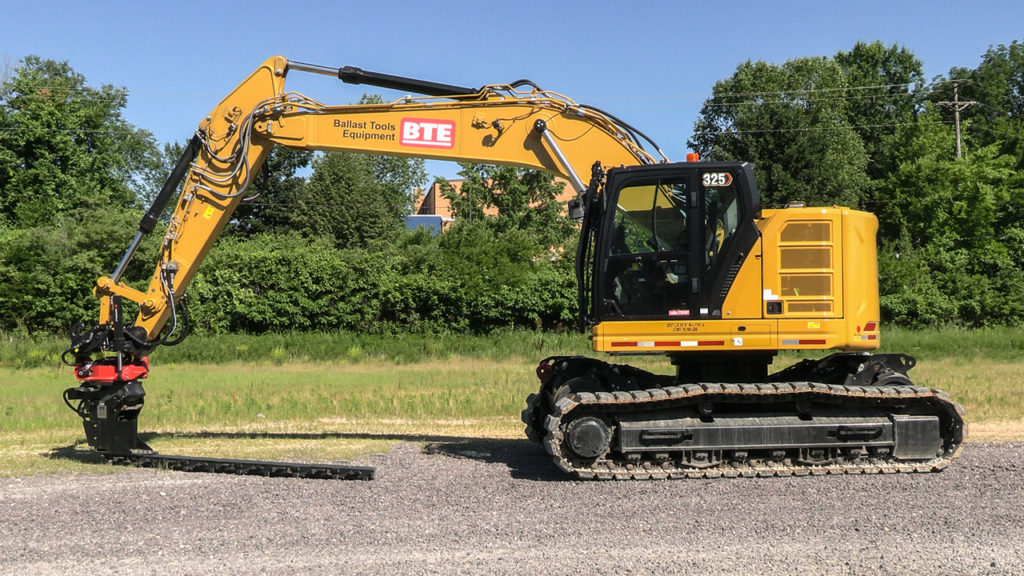
BTE
BTE of Festus, Mo., recently introduced its next generation of ballast maintenance equipment. Starting with the BTE-325 Hi-Rail Next Gen Excavator, BTE says it has introduced new innovations to the platform to increase productivity, safety and reliability. Now, the BTE-326 Hi-Rail Excavator has made its way out to the field with even more safety and reliability features.
“Our customers are looking for increased efficiency to tackle maintenance challenges through mechanics and technology,” said BTE Marketing Media Producer Ray Warren. “This includes reducing time to fix spot maintenance issues while increasing track safety,” said Warren, who adds that BTE is “busier than ever” as its customers are experiencing “unprecedented” maintenance challenges that the company doesn’t see slowing down in the next two years. “We are bringing cutting edge technology not only to operating the platforms we offer, but also to the actual mechanics of the machines,” said Warren.
“Working directly with CAT, our engineers have developed root level software and incorporated it into the system, allowing the platform to better manage flow pressures and increase power to attachments while the machine is in motion,” said BTE Sales Engineer Matt Weyand. “Our exclusive partnership with CAT allowed us to bring to the platform the most asked for features our customers wanted. Adding to our attachment recognition system, the new machine firmware creates a seamless interface for the operator. Our engineers really took this project to the next level, to create cutting edge technology that has proven to increase productivity in maintenance situations.”
In addition to developing next generation software with CAT, BTE has upgraded the Hi-Rail systems of these next-generation machines. “Our BTE exclusive heavy duty Hi-Rail system allows for long tramming of the machine without the heating issues inherent in some systems,” said Weyand. “This capability, coupled with our heavy-duty motor and exclusive braking system, brings a new level of productivity and safety to the platform.”
When asked about the overall ballast market this past year, Weyand replied, “Here at BTE, our customers have created demand for our next-generation machines. The need is there, the challenges never stop, and we are proud to be able to bring new technology and better reliability to our customers to meet their ever-changing needs. Moving forward, we are bringing new attachments online this year to help our customers to be more efficient than ever before. This market faces constant challenges with regards to spot repairs, disaster recovery and general maintenance issues. BTE will continue to introduce new ideas and technologies to face those challenges, now and in the future.”
BTE says it is also developing a “revolutionary” warning system to not only warn operators of fouled track but also to warn individuals of approaching machines.
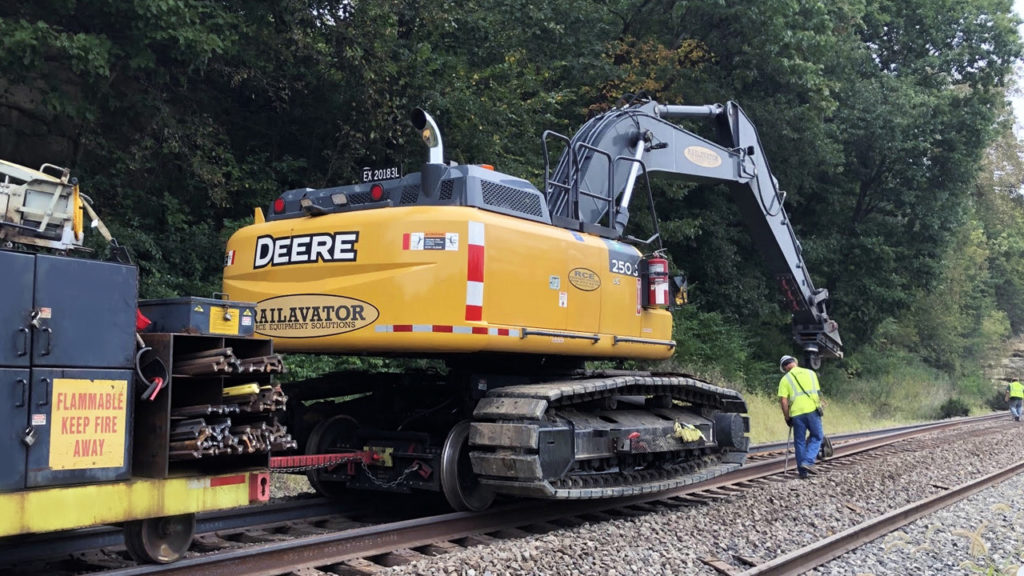
RCE
“The current business market remains strong for us,” RCE tells Railway Age. “There is a lot of demand from our rail and contractor customers, but our biggest challenge still remains supply chain management.”
In August 2022, RCE released several product announcements. These include:
New Series 5 P Swing Loaders: The new Series utilize a John Deere 544 P model machine with enhanced performance, efficiency and comfort “so customers can hit the heavy jobs harder,” RCE says. The new P model wheel loaders provide spacious operator stations, including customizable ergonomic electrohydraulic (EH) controls, and streamlined electrical and hydraulic routing, making these versatile and productive mid-size models “the perfect match to take rail maintenance operation to the next level.” The standard loader boom and housing has been replaced with a 200-degree turntable that allows the operator to accomplish swing crane functions. The main boom assembly retains its structural integrity allowing the Series 5 to accomplish wheel loader functions with 14,500 pounds of lift capacity. Equipped with the high traction axles, the Series 5 Swing Loader has enough drawbar pull to handle the positioning of continuous rail. Whether working on or off rail, the Series 5 Swing Loader “provides a powerful, safe machine that offers the reliability of John Deere wheel loaders and the ultimate in swing crane technology,” RCE says.
New Series Railavators–John Deere Models 210G, 245G and 250G Hi-Rail Excavators: The Railavator hi-rail excavator is RCE’s most popular machine because of its quality and versatility, RCE says. With its patented hydraulically powered retractable hi-rail, customers can take it anywhere they need, on and off track. The New Series 210G, 245G and 250G Railavators boast RCE’s new Ultra Life Axles. These final drives are made of high strength alloy steel with double the structural strength of existing cast iron final drives. Many rail maintenance operations require severe duty applications with high point loading. The Ultra Life Axles have overall increased axle bearing capacity, are rebuildable/repairable and have a three-year/unlimited hours warranty.
The New Series Railavators have many design enhancements, including a new hydraulic system. There are more components in the common manifold, which means fewer hoses, separate components and joints to potentially leak. The F-N-R valves are now pilot-operated without electrical coils, which makes for a more reliable design, RCE says. RCE also updated the Railavator structure, including the hi-rail linkages and supports, extending support gussets and adding weight to the links and frames. These modifications reduce frame flexing and potential cracking. The main drive frame is aligned in all axes for drive components. The drive axle mount- ing has been changed for more strength and durability, as well as the axle mount and front/rear bumpers and tow points. The improved rotary manifold has a higher-pressure rating and longer life. And the push button monitor—which, according to RCE, is “raved about by its customers for its intuitiveness and ease of use”—controls the hi-rail and all available attachments from inside the cab.
Adjustable Lower Track Frames: The 50G, 85G and 135G Railavators feature an adjustable lower track frame. When retracted, the machine is under the legal size for transit without a required permit. In work mode, the hydraulically operated frame expands to straddle the track. “Maintenance crews will appreciate this ease of transport,” RCE says.
All Makes Rail Gear: RCE provides all makes high rail gear for Komatsu, Caterpillar and John Deere 20-metric-ton excavators. The high rail gear is RCE’s patented hydraulic high rail system. The 20-metric class Railavator, RCE says, is ideal for rail maintenance applications, such as rail laying, tie handling, scrap pick-up, ballast, and site preparation and undercutting. The rail gear package can be fitted with features and designed to simplify service and minimize downtime and expense.
Attachments: Railavators are “the Swiss army knife of m/w equipment,” RCE says, and can be equipped with more than 20 attachments.
Recent industry trends include more compact product options and data connectivity. “Our 50G, 80G and 135G Railavators are gaining traction with rail and contractors looking to work in more compact environments, as well as ease of transport,” notes RCE. “We are also looking for ways to better support our customers remotely. Our equipment is equipped with JDLink telematics and remote support options, which provide us new ways to support and train our customers that don’t require a trip into the field.”
HERZOG
In the days following Hurricane Ian, which ravaged southwest Florida and left railroads scrambling to restore tracks where washouts from high winds and rain occurred, CSX deployed Herzog’s Automated Conveyor Train (ACT) to assist with the reconstruction of impacted tracks near Ona, Fla., Herzog tells Railway Age.
Designed to deliver high volumes of ballast quickly, the ACT conveyor arm reaches areas 50 feet from track center and can stockpile material or distribute ballast in precise areas along the right-of-way. For this automated solution, only a single operator is needed, which means “increased safety and operational efficiency on the line,” Herzog says.
“The ACT has proven to be a key resource for emergency response and will help the CSX restore critical rail access for these communities affected by this devastating hurricane,” said Herzog Vice President of Ballast Operations and Railcar Leasing Ryan Crawford. “Because CSX utilizes its ACT year-round for routine maintenance, when disaster strikes, they can deploy it at a moment’s notice to help accelerate rebuilding efforts.”
When stockpiling, according to Herzog, the ACT can unload an entire 30-car consist in under two hours, even in curves and S-curves. Its automated plow can strike off any ballast unloaded in the center of the track directly in front of the discharge car.
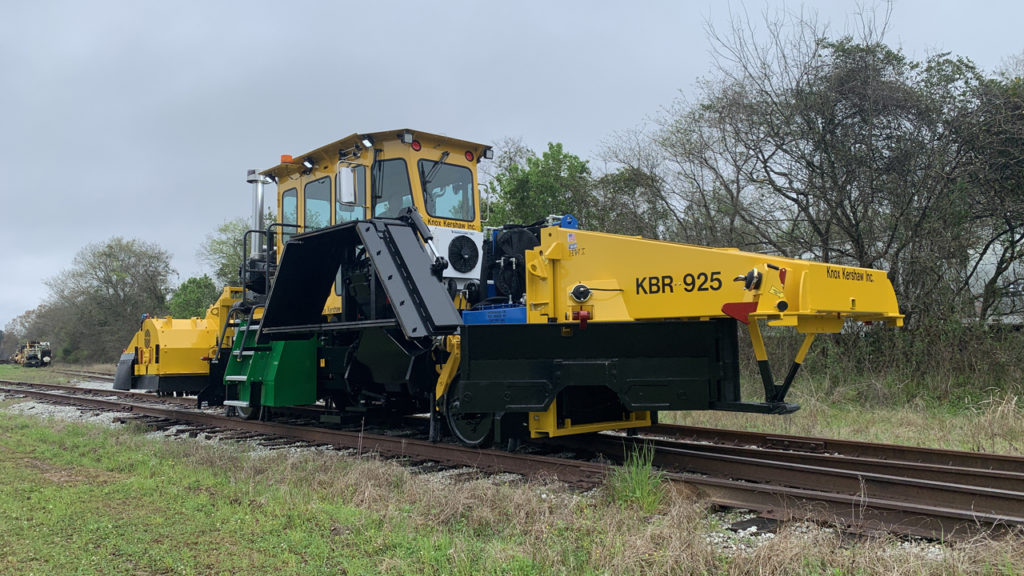
KNOX KERSHAW
Advancements in automation and systems monitoring are making Knox Kershaw machines easier and safer than ever to operate, the company says. KnoxKershaw’s KBR 925 Ballast Regulator, designed for ballast work on all types of track, now includes the Plus+1® System Option allowing the machine to automate key functions to make operation smoother, as well as a touch screen to monitor system functions. The new control system by Danfoss controls machine functions and displays machine diagnostics, including engine parameters (RPM, temperature, pressure, level, DEF, voltage, engine hours and faults), hydraulic and air pressures, turntable position, travel/work speed, fuel level, hydraulic temperature and level, transmission temperature, filter conditions, active transmission gear, travel direction, control joysticks and switches, valve bank coils and broom hours, to help operators optimize productivity.
The Plus+1® system is also an option on the company’s KSF 940 machine and comes standard on the KKA 1050, KTC 1250 and KPB 200.
Visibility in every direction, especially the wing areas, makes the KBR 925 “the ideal machine for final profiling,” Knox Kershaw says. The specially designed plow used in conjunction with the wing makes transferring from shoulder to shoulder a one-pass operation; the reversible wings allow work in either direction, so no movement is lost; the insulated broom box gives excellent service life; and the standard reversing valve allows ballast to be swept away from switches and road crossings.
Additional upgrades to the KBR 925 include:
- Hydraulic tank relocated to front of machine for improved weight distribution.
- Increased hydraulic tank capacity of 130 gallons.
- Dual fuel tanks increase capacity from 110 to 220 gallons and fill from either side.
- Hydraulic and fuel tanks fabricated from Core 10 steel for improved life.
- Sloped fuel tanks with integral steps improve cab entry and exit.
- Angled access steps for ease of entrance.
- Ballast wing utilizes the same grader blade throughout.
- Distributive wiring in mainframe for troubleshooting ease.
- Moved A/C to the front of the cab for added visibility and operator comfort.
- Improved cab pressurization.
- Service brake handle located on seat.
- Improved brake arm adjustment.
- All LED lighting.
- Upgraded step material to grating for better drainage and grip.
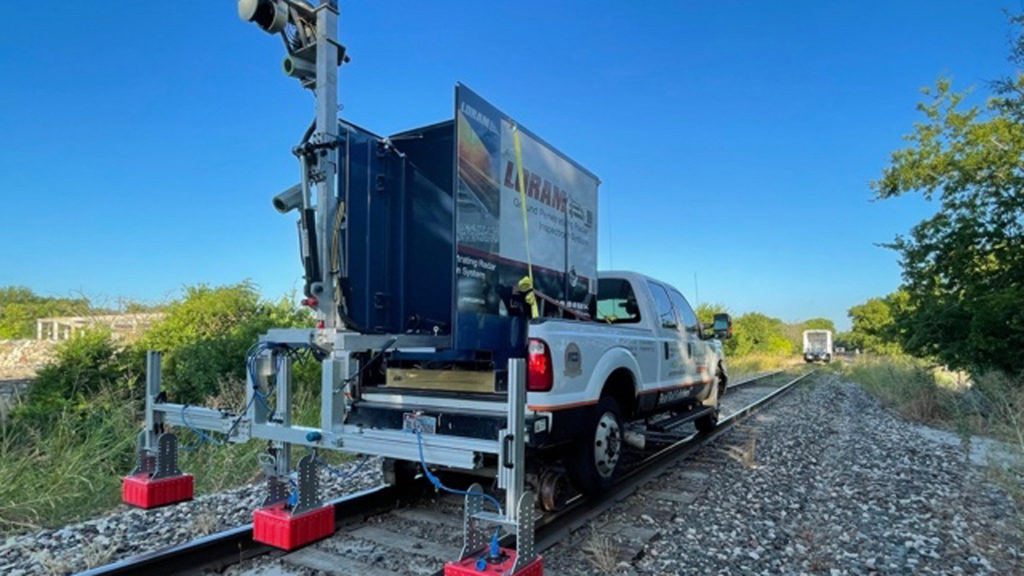
LORAM
The most recent research presented at the American Railway Engineering and Maintenance-of-Way Association (AREMA) 2022 Annual Conference & Expo, which took place this past August, highlighted the importance of ballast maintenance, Loram tells Railway Age. Papers presented demonstrated the effectiveness of shoulder ballast cleaning by quantifying the improvement in drainage realized, as well as the improvement in center fouling over time. Analysis was also presented showing the lower total cost of ownership when utilizing a scheduled shoulder ballast cleaning program.
Loram says its customers, both domestically and internationally, are turning to data gathering and analysis to make informed decisions about where to spend their ballast maintenance budgets. “In the current era, where there is an increased FRA scrutiny of mud spots and limited maintenance windows, a premium is being placed on ensuring that the right work is being done at the locations that need it most,” the company says. “Customers are moving beyond the adage of, ‘I know where my mud is’ and looking for technology partners that can give them the depth of understanding necessary to ensure that their maintenance dollars will be spent to solve root causes of issues, not just symptoms.”
Good planning is the key to effective ballast maintenance, and understanding the current state of the track is the first step, Loram tells Railway Age, adding that the company’s inspection equipment can utilize GPR (ground penetrating radar), LiDAR (light detection and ranging), linescan, x-ray tie inspection and video to assess the entire track structure. When this data is aligned with railroad supplied geometry history (to provide overall trending), a complete analysis of the track can be completed and used to inform planning. Loram says it can partner with the railroad to “develop multi-year maintenance plans to fit with a customer’s budget and remediate/maintain as much track as possible in the most cost-effective manner.”
GPR, LiDAR, and geometry data are often used together to target where different types of ballast maintenance should be executed, Loram says. Areas with high shoulder fouling and moderate crib fouling are candidates for shoulder ballast cleaning alone, while high center fouling paired with persistent geometry issues may be a target for subgrade stabilization before undercutting. High fouling and moisture retention around bridge abutments, road crossings or switches can be targeted for vacuum excavation.
For example, Loram says GPR data can be used to identify areas that require undercutting or shoulder ballast cleaning. The total fouling data can then be paired with LiDAR data to plan the ballast cleaning task by identifying the current ballast volume and calculating how much the volume will be reduced by removing the fouling material. This data, Loram concludes, can be used to determine how much ballast will need to be delivered to restore the track to the target ballast profile.

